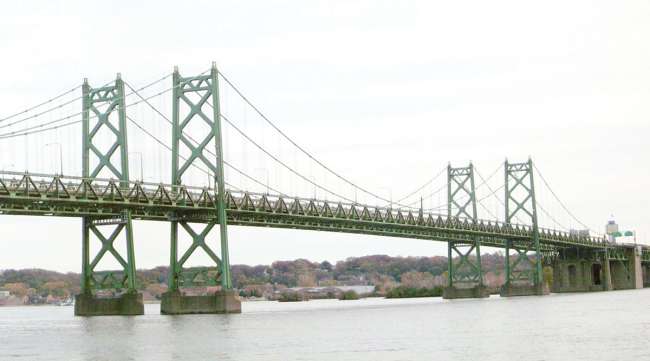Staff Reporter
Iowa Transportation Commission Approves Five-Year Plan

[Stay on top of transportation news: Get TTNews in your inbox.]
The Iowa Transportation Commission recently approved the state’s transportation improvement program, which maps out infrastructure investments over the next five years.
The program, which considers fiscal years 2021 through 2025, covers investments in the multimodal transportation system, including highways, railroads, aviation, transit and trails. The commission’s seven members approved the program at their meeting June 9.
Over the next five years, some $3.6 billion is forecast to be dedicated to highway projects. About 55% of this funding will be directed to rural areas. More than $2 billion is programmed for modernizing the existing highway system and enhancing safety features.
“A good portion of that program is focused on the interstate system, which carries most of the freight traffic in the state of Iowa, and a lot of the passenger vehicle travel as well,” said Stuart Anderson, director of Iowa DOT’s Planning, Programming and Modal Division. “With Iowa being located right in the middle of the country, we get a lot of traffic crossing the state of Iowa.”
Highway projects include work on major routes, such as lane improvements on Interstate 35 in Polk and Story counties, which sit adjacent to each other in the center of the state. I-35 is a major north-south route that bisects Iowa.
The area surrounding the Interstate 74 bridge connecting Iowa with Illinois over the Mississippi River. (Google Maps)
The agency will continue work on the I-74 bridge, a tandem project of the Iowa and Illinois departments of transportation which will widen the structure from two lanes to four. The I-74 bridge, which traverses the Mississippi River, consists of two spans that run from Moline, Ill., to Davenport, Iowa. The cities help make up the Quad Cities area, the region where eastern Iowa and northwestern Illinois meet. Also in the Quad Cities area, Iowa DOT plans to replace the I-80 bridge over the Mississippi River. This crossing is located about 12 miles east of the I-74 bridge.
The program outlines various improvements to I-80, which runs east-west through Iowa and channels heavy truck traffic. Specific projects include the I-80/380 interchange reconstruction near Iowa City and lane improvements in Dallas and Johnson counties. Anderson said the current I-80/380 interchange has tight curves that can be a challenge for freight haulers. He noted that the stretch of I-80 in Dallas County, which is west of Des Moines, needs bridge repair work and lane additions.
“Interstate 80 has always been a big focus,” Anderson said. “We see a tremendous amount of freight volume on Interstate 80. Frankly, any improvements on Interstate 80 have a really significant freight benefit to improve not only the condition of the pavement, but to provide more safety by having more lanes where necessary and broader interchange improvements to more efficiently move vehicles and truck traffic.”
Three interstates run through Council Bluffs, Iowa. (Google Maps)
Iowa DOT also plans to reconstruct the interstate system in Council Bluffs. Three interstates — I-80, I-29 and I-480 — run through Council Bluffs, which is located directly across the Missouri River from Omaha, Neb. According to Iowa DOT, the Council Bluffs Interstate System typically carries between 20,000 and 76,000 vehicles a day.
“Council Bluffs is part of the Omaha metro area, so we see a lot of railroads in the area,” Anderson said. “Between serving both Interstate 29 and Interstate 80, we see a lot of freight connections in the area.”
The program includes $1.1 billion in investments for state-owned bridges. Over the past few years, Iowa DOT has focused on improving the condition of bridges. According to the American Road and Transportation Builders Association, 19% of Iowa’s bridges are classified as structurally deficient.
Anderson acknowledged there is concern about the COVID-19 pandemic’s impact on transportation funding. He noted the $3.6 billion figure is based on pre-pandemic revenue estimates. Iowa DOT is expecting road funding to drop over the next several months due to reductions in travel and vehicle sales amid the pandemic.
In mid-April, Anderson said traffic was down 44% compared with levels during the same week in 2019. Since then, traffic volumes slowly have started to climb back to normal levels.
Future funding estimates will require a comprehensive federal transportation package, according to Iowa DOT. The current authorization bill, the Fixing America’s Surface Transportation (FAST) Act, expires Sept. 30. The House Transportation and Infrastructure committee on June 3 unveiled a $494 billion legislative proposal meant to update the FAST Act.
“We certainly will have several months of reduced state revenue, at a minimum,” Anderson said. “We’re estimating, from June through October, the state of Iowa will be down about $100 million. We need a reauthorization bill to keep that funding going.”
Want more news? Listen to today's daily briefing:
Subscribe: Apple Podcasts | Spotify | Amazon Alexa | Google Assistant | More




